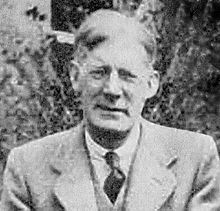Battiscombe Gunn
|
Professor Battiscombe Gunn FBA |
|
|---|---|
 |
|
| Born |
Battiscombe George Gunn 30 June 1883 London, England |
| Died | 27 February 1950 (aged 66) Oxford, England |
| Cause of death | Heart failure |
| Nationality | English |
| Title | Professor of Egyptology (1934–1950) |
| Spouse(s) | Lillian Florence Meacham Constance Rogers |
| Children | J. B. Gunn |
| Awards | Fellow of the British Academy |
| Academic background | |
| Education |
Bedales School Westminster School Allhallows School University College, London |
| Academic work | |
| Discipline | Egyptology and Philology |
| Institutions |
Egyptian Museum, Cairo Penn Museum, Philadelphia University of Oxford |
| Notable students |
Alec Naylor Dakin T. G. H. James |
| Influenced | J. W. B. Barns |
Battiscombe "Jack" George Gunn, FBA (30 June 1883 – 27 February 1950) was an English Egyptologist and philologist. He published his first translation from Egyptian in 1906. He translated inscriptions for many important excavations and sites, including Fayum, Saqqara, Amarna, Giza and Luxor (including Tutankhamun). He was curator at the Egyptian Museum in Cairo and at the University Museum at the University of Pennsylvania in Philadelphia. In 1934 he was appointed Professor of Egyptology at the University of Oxford, a chair he held until his death in 1950.
Gunn was born in London, the son of George Gunn, a member of the , and Julia Alice Philp. His paternal grandprents were Theophilus Miller Gunn FRCS, a prominent London surgeon originally from Chard, and Mary Dally Battiscombe, from Bridport. Theophilus's father was John Gunn, a non-conformist preacher, brother of Daniel Gunn, originally from Wick in Scotland, but who spent most of his career in Chard. Both sides of the family were non-conformist. His unusual first name came from his grandmother's maiden name.
He was educated at Bedales School, Westminster School and Allhallows School, Honiton. These public schools were more liberal than the conventional Victorian Public Schools, and provided an open-minded environment. Bedales, in those days, attracted nonconformists, agnostics and liberal Jews. It had connections to Fabian intellectual circles, and to the Wedgwoods, Darwins, Huxleys and Trevelyans. At the age of 14, while still in school, he began to read hieroglyphs. He then went to a tutor in Wiesbaden, but returned to London at the age of 18, due to a change in family finances.
...
Wikipedia
